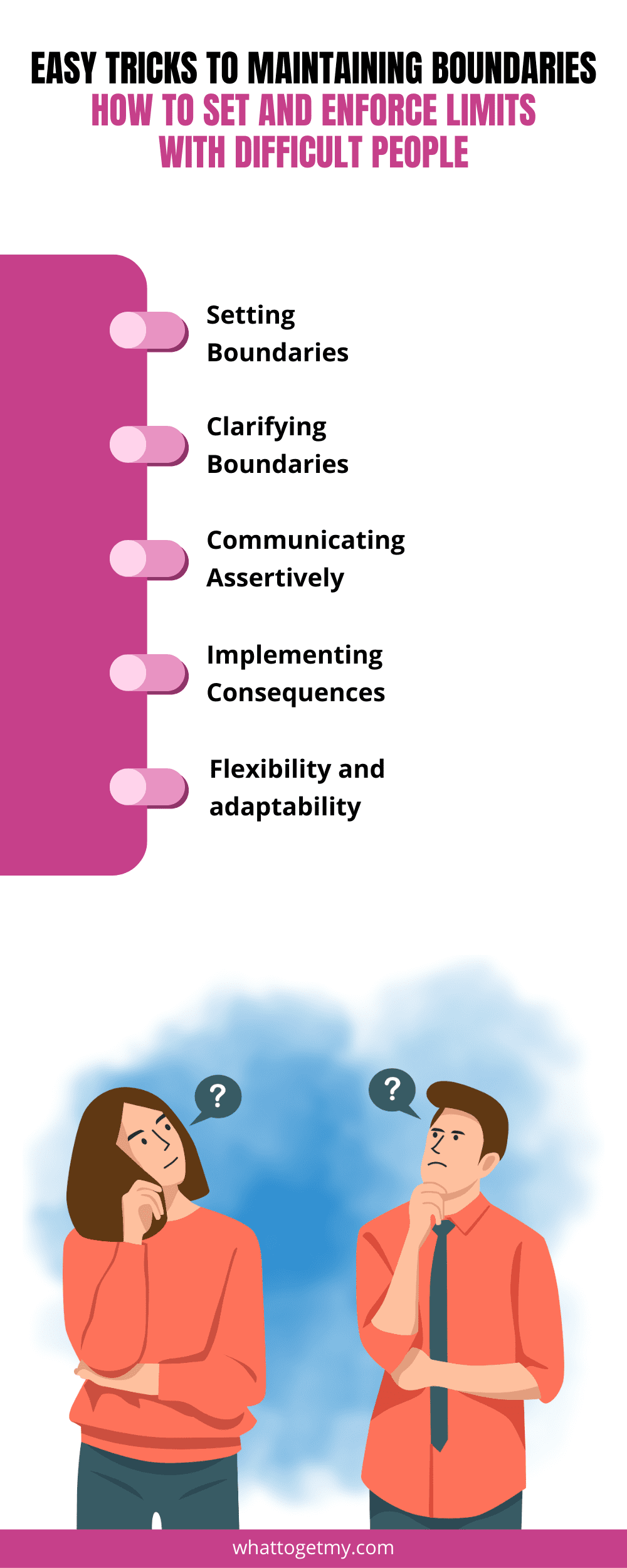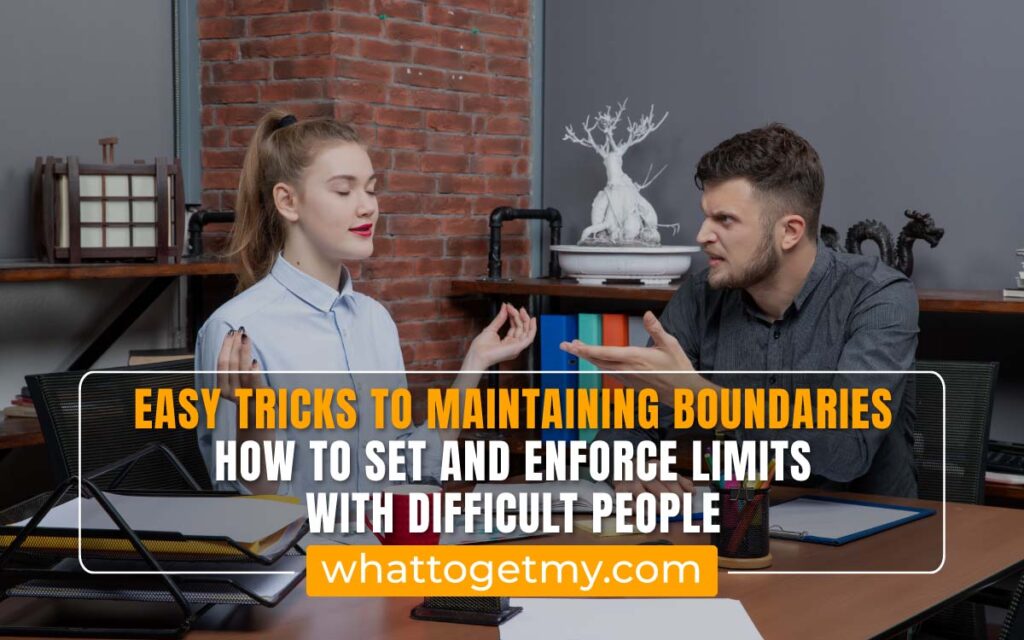3 Easy Tricks to Maintaining Boundaries: How to Set and Enforce Limits with Difficult People DIY (2023)
Maintaining healthy boundaries is essential when dealing with difficult people. Whether it’s a challenging colleague, a toxic family member, or a demanding friend, setting and enforcing limits is crucial for protecting our well-being and fostering healthier relationships.
Now that we understand the importance of setting boundaries let’s explore practical strategies for effectively establishing and upholding them in challenging relationships.
When communicating assertively, it’s important to remember that setting boundaries is about taking care of yourself and maintaining your well-being.
Implementing consequences is a critical aspect of maintaining boundaries with difficult people.
Reflect on your values, needs, and emotional well-being to determine what is acceptable and crosses the line in your interactions with difficult people.
Maintaining healthy boundaries is essential when dealing with difficult people. Whether it’s a challenging colleague, a toxic family member, or a demanding friend, setting and enforcing limits is crucial for protecting our well-being and fostering healthier relationships. This comprehensive guide will teach you how to set and enforce limits with difficult people and explore practical strategies and techniques for setting and enforcing limits in challenging relationships. By maintaining healthy boundaries with difficult individuals, you can regain control, establish healthier interactions, and prioritize your emotional and mental health.
I. The Importance of Setting Boundaries with Difficult People
Setting boundaries with difficult people is vital to self-care and maintaining healthy relationships. When we clearly define our limits, we create a safe space to protect our well-being and establish mutual respect. Here are some key insights on the significance of setting boundaries:
1. Setting Boundaries with Difficult People
– Defining your limits when interacting with challenging individuals.
– Recognizing the impact of boundary violations on your emotional health.
– Understanding the connection between self-worth and boundary-setting.
Setting boundaries with difficult people is crucial to maintaining well-being and creating healthier relationships. It involves clearly defining our limits and expectations when interacting with challenging individuals. Here are some key points to consider when setting boundaries with difficult people:
1. Defining your limits when interacting with challenging individuals:
Setting boundaries starts with understanding and defining your limits. Reflect on your values, needs, and emotional well-being to determine what is acceptable and crosses the line in your interactions with difficult people. This may include identifying specific behaviors, topics, or actions that make you uncomfortable or violated. Then work on developing strategies for setting and enforcing limits.
2. Recognizing the impact of boundary violations on your emotional health:
Boundary violations can significantly impact your emotional well-being. That is why learning the value of navigating difficult relationships through boundary setting is crucial. When your boundaries are crossed, it can lead to feelings of anger, frustration, resentment, or even a loss of self-esteem. Recognizing the negative impact of these violations is essential in understanding why setting boundaries is necessary for your emotional health and overall well-being.
3. Understanding the connection between self-worth and boundary-setting:
Setting boundaries is closely tied to your sense of self-worth and self-respect. When you establish boundaries, you communicate to yourself and others that you value your needs and priorities. It is an act of self-care and self-preservation. Recognizing your worth can establish boundaries that protect your emotional and mental health and promote healthier relationships.
When setting boundaries with difficult people, it’s important to communicate them clearly and assertively. Respectfully express your limits and expectations, using “I” statements to convey how their behavior affects you personally. Remember that setting boundaries is not about changing the other person but creating a safe space for yourself. It may require consistency and reinforcement as you navigate complicated interactions, but by honoring and enforcing your boundaries, you empower yourself to maintain healthier relationships and preserve your well-being.
II. Strategies for Setting and Enforcing Limits
Now that we understand the importance of setting boundaries let’s explore practical strategies for effectively establishing and upholding them in challenging relationships. These techniques will empower you to navigate complicated interactions and protect your well-being:
1. Clarifying Your Boundaries
– Establish clear boundaries by reflecting on your values, needs, and limits.
– Identifying specific behaviors or actions that cross your boundaries.
– Recognizing patterns and triggers in complicated relationships.
Clarifying your boundaries is essential in setting and maintaining healthy relationships with difficult people. It involves reflecting on your values, needs, and limits to establish clear and well-defined boundaries. Here are some key points to consider when clarifying your boundaries:
1. Reflecting on your values, needs, and limits to establish clear boundaries:
Take a moment to reflect on what is important to you, what you value in relationships, and your personal needs and limits. This self-reflection helps you better understand yourself and what you require to feel safe, respected, and emotionally secure in your interactions with others.
2. Identifying specific behaviors or actions that cross your boundaries:
Once you better understand your values, needs, and limits, you can identify behaviors or actions that are not acceptable to you. These could be actions that make you feel uncomfortable, disrespected, or violated somehow. It is essential to be clear about what behaviors cross your boundaries so that you can communicate them effectively to others. This identification is the foundation of boundary maintenance with troublesome individuals.
3. Recognizing patterns and triggers under challenging relationships:
Complicated relationships often have patterns and triggers that can lead to boundary violations. Take the time to observe and reflect on the dynamics of these relationships. Are there specific situations or behaviors that consistently push your boundaries? Are there specific triggers that tend to elicit negative emotions or discomfort? By recognizing these patterns and triggers, you can be better prepared to establish boundaries and respond assertively when faced with challenging situations.
Clarifying your boundaries requires self-awareness and a willingness to prioritize your well-being. It may take time and practice to become comfortable with asserting your boundaries, but it is an essential step toward maintaining healthier relationships. Remember, boundaries are personal and individual, and it is your right to define and uphold them. By clarifying your boundaries, you can confidently navigate complicated relationships and create spaces that support your emotional and mental well-being.
2. Communicating Assertively
– Use practical communication skills to express your boundaries respectfully.
– Employing “I” statements to convey your feelings and needs without blaming.
– Practicing active listening to promote understanding and dialogue.
When considering techniques for setting and enforcing boundaries with difficult people communicating deserves pride of place.
Communicating assertively is valuable for setting and maintaining boundaries with difficult people. It involves expressing yourself clearly, confidently, and respectfully while effectively conveying your boundaries. Here are some key points to consider when practicing assertive communication:
1. Using practical communication skills to express your boundaries respectfully:
Assertive communication involves using clear and direct language to express your boundaries. Be specific about what is acceptable and what is not, using assertive phrases such as “I would prefer,” “I need,” or “I am not comfortable with.” Be clear and active in your communication, which can lead to misunderstandings or misinterpretations.
2. Employing “I” statements to convey your feelings and needs without blaming:
“I” statements are a powerful tool in assertive communication. They allow you to express your feelings and needs without blaming or attacking the other person. By focusing on your own experiences and emotions, you take ownership of your boundaries and create a non-confrontational atmosphere for discussion.
3. Practicing active listening to promote understanding and dialogue:
Active listening is essential to assertive communication. It involves giving your full attention to the other person, demonstrating genuine interest, and seeking to understand their perspective. By actively listening, you show respect and create an environment where complex individuals feel heard and validated. This, in turn, fosters mutual understanding and can lead to more constructive dialogue and problem-solving.
When communicating assertively, it’s important to remember that setting boundaries is about taking care of yourself and maintaining your well-being. You can effectively communicate your needs and expectations by expressing your boundaries respectfully and listening actively while promoting healthy and respectful relationships with difficult people.
According to Statista, in the year 2020, a significant portion of individuals in Poland, amounting to 27 percent, expressed the belief that maintaining professional boundaries is essential in workplace relationships.
3. Implementing Consequences
– Establishing and communicating consequences for boundary violations.
– Following through with consequences to reinforce the importance of respecting your limits.
– Adjusting consequences based on the severity and frequency of boundary crossings.
Implementing consequences is a critical aspect of maintaining boundaries with difficult people. Establishing and communicating consequences for boundary violations creates a sense of accountability and reinforces the importance of respecting your limits. Following through with the consequences you set is crucial to show that you are serious about maintaining your boundaries. The consequences can vary depending on the situation and individual, and it is important to adjust them based on the severity and frequency of the boundary crossings. This helps in establishing clear expectations and promotes healthier interactions within the relationship.

III. Effective Boundary Management Techniques
Navigating challenging relationships requires a proactive approach to boundary management. You can maintain healthy boundaries and promote constructive interactions by mastering effective boundary management with difficult people. Here are some techniques to consider:
1. Self-Care and Boundary Maintenance
– Prioritizing self-care activities that nurture your emotional well-being.
– Recognizing signs of boundary erosion and establishing and upholding boundaries in challenging situations.
– Seeking support from trusted friends, family, or professionals when needed.
Self-care is crucial in maintaining healthy boundaries and limits for dealing with difficult individuals. By prioritizing activities that nurture your emotional well-being, such as practicing mindfulness, engaging in hobbies, or seeking therapy, you can effectively strengthen your ability to enforce boundaries. It is essential to be aware of signs of boundary erosion, such as feeling overwhelmed, compromised, or disrespected, and take immediate action to reinforce your boundaries. This may involve assertively communicating your needs, reassessing your limits, or distancing yourself from toxic relationships if necessary. Seeking support from trusted friends, family, or professionals can provide guidance, validation, and additional strategies for maintaining boundaries. Remember, self-care and boundary maintenance go hand in hand, and by taking care of yourself, you empower yourself to navigate complicated relationships with greater resilience and well-being.
2. Flexibility and Adaptability
– Understanding that boundaries may evolve over time and in different circumstances.
– Assessing the feasibility of adjusting boundaries to accommodate certain relationships.
– Balancing assertiveness with empathy and understanding.
Flexibility and adaptability are essential qualities when it comes to maintaining boundaries with difficult people. Recognizing that boundaries may need to evolve over time and in different circumstances allows for a more realistic and dynamic approach. It’s essential to assess the feasibility of adjusting boundaries to accommodate certain relationships, considering factors such as the level of trust, the willingness of the other person to respect boundaries, and the overall importance of the relationship in your life.
Balancing assertiveness with empathy and understanding is vital. While it’s essential to communicate and enforce your boundaries assertively, it’s also crucial to consider the perspectives and needs of others. Striking a balance between assertiveness and empathy allows for open and respectful dialogue, increasing the likelihood of finding mutually beneficial solutions.
Flexibility and adaptability in boundary-setting do not mean compromising your core values or tolerating toxic behavior. It means being open to reevaluating and adjusting boundaries as needed while still prioritizing your well-being and ensuring that your limits are respected. Incorporating flexibility and adaptability into your approach allows you to navigate challenging relationships more effectively.
3. Self-Reflection and Growth
– Regularly reflecting on your boundary-setting journey and evaluating its effectiveness.
– Embracing personal growth and adapting boundaries to align with evolving values.
– Celebrating milestones and achievements in maintaining healthy boundaries.
Self-reflection and growth are vital components of maintaining boundaries with difficult people. It’s essential to regularly reflect on your boundary-setting journey and evaluate the effectiveness of your implemented strategies. Consider whether your boundaries serve their intended purpose and if any adjustments or improvements are needed.
Embracing personal growth involves recognizing that boundaries may need to evolve as your values, priorities, and understanding of yourself change over time. Adapt your boundaries to align with your evolving beliefs and needs. This process may involve reassessing relationships, redefining limits, and exploring new ways to communicate and enforce boundaries assertively.
It’s important to celebrate milestones and achievements in maintaining healthy boundaries. Recognize and acknowledge your progress along the journey. These celebrations can reinforce your commitment to boundary-setting and motivate you to continue growing.
Self-reflection and growth are ongoing processes. Regularly assess your boundaries, make necessary adjustments, and embrace the opportunities for personal development that come with maintaining healthy boundaries. By engaging in self-reflection and embracing growth, you can enhance your ability to set and enforce boundaries with difficult people, fostering healthier relationships and greater personal well-being.
Frequently Asked Questions
1. How do I set boundaries with difficult people without causing conflict?
A1: Setting boundaries with difficult people can be challenging, but there are strategies to minimize conflict. Start by clearly defining your boundaries and communicating them assertively but respectfully. Use “I” statements to express your feelings and needs without blaming or accusing the other person. Focus on expressing your limits rather than trying to change the other person. Maintaining a calm and composed demeanor and emphasizing mutual respect can reduce the likelihood of conflict while setting clear boundaries.
2. What if someone continues to violate my boundaries despite my efforts?
A2: Enforcing consequences is crucial if someone persistently violates your boundaries despite clear communication. Communicate the consequences of boundary violations and be prepared to follow through with them consistently. Consequences can range from reducing contact with the individual to ending the relationship altogether, depending on the severity of the boundary violations. By consistently enforcing consequences, you send a strong message that your boundaries are non-negotiable and deserve respect.
3. How can I maintain boundaries with difficult people in professional settings?
A3: Maintaining boundaries with difficult people in professional settings requires a diplomatic approach. Start by clearly defining your professional boundaries and expectations. Communicate your limits professionally but assertively, using “I” statements and focusing on maintaining a respectful work environment. Be proactive in addressing boundary violations, such as discussing the issue privately with the individual or seeking guidance from a supervisor or HR department if necessary. Prioritizing your well-being and maintaining professional boundaries is essential to ensure a healthy and productive work environment.
IV. Conclusion
Maintaining boundaries with difficult people is an ongoing process that requires self-awareness, assertiveness, and self-care. By utilizing the strategies and techniques outlined in this article, you can establish and enforce limits, cultivate healthier relationships, and protect your emotional well-being. Remember, setting boundaries is an act of self-respect and an essential tool for navigating complicated interactions with confidence and integrity.
02 HOURS 06 MINUTES
ESTIMATED TIME DESIGNING AND UPLOADING THIS ARTICLE
08 HOURS 36 MINUTES
ESTIMATED TIME RESEARCHING AND WRITING THIS ARTICLE
LOOKING FOR MORE GIFTS?
Try our AMAZING GIFT FINDER TOOL! Find GIFTS with 1 CLICK!
LOOKING FOR MORE GIFTS?
Try our AMAZING GIFT FINDER TOOL! Find GIFTS with 1 CLICK!
LOOKING FOR MORE GIFTS?
Try our AMAZING GIFT FINDER TOOL! Find GIFTS with 1 CLICK!
You Might Also Like

What To Get A Coffee Lover | 34 Best Coffee Gifts
This gift article has the answer to your question of what to get a coffee lover. In this article, you will find the best coffee enthusiast gifts for the coffee lover/addict in your life. If you’re looking for coffee addict gifts for your coffee addict

Fun Things to Do With 1000 Dollars
Fun Things to Do With 1000 Dollars WhatToGetMy Instructional Article Do you have a thousand dollars to blow up and are you wondering what cool things to spend your money on? This is the article for you. They say “all work and no play makes
Fun-Filled Memorial Day Weekend in San Diego: Your 2025 Adventure Guide
Fun-Filled Memorial Day Weekend in San Diego: Your 2025 Adventure Guide So, you’re thinking of hitting the San Diego beaches this summer? Smart move, kid! The water’s finally warm enough that your toes won’t turn into popsicles when you dip them in. Pack your sunscreen (trust me, that “natural tan” you’re hoping for is just

What to Do on 21st Birthday Without Friends
What to Do on 21st Birthday Without Friends WhatToGetMy Instructional Article Spending your 21st birthday alone has a world of benefits and can be fun and exciting. It gives you the chance to connect with the inner you. It also allows you to learn the

Secret Santa Gift Ideas for Managers
Being a secret Santa is sometimes really stressful. Nobody will know what you got, that’s true, but you will! How are you supposed to live with yourself knowing that you gave a wrong gift to somebody? As if things couldn’t be any worse, you pulled
Where to Rest Your Head in Salzburg: The Ultimate Neighborhood Guide
Where to Rest Your Head in Salzburg: The Ultimate Neighborhood Guide Planning a trip to Austria’s musical wonderland? Let’s figure out exactly where you should unpack your suitcase! Picture narrow cobblestone streets where Mozart probably spilled his coffee rushing to a concert—that’s Altstadt for you! This maze of medieval buildings and hidden courtyards feels like

Teenagers Interests and Hobbies
Teenage Interests and Hobbies: Why You Should Help Adolescents Find their Passion. WhatToGetMy Instructional Article If you’re thinking adults can’t relate to teenage interests and hobbies, you’re probably right. Being a teenager is probably one of the hardest things in life. Between looming SAT exams

15 Cool Gifts for a Firefighter Boyfriend
They are ever ready to put their lives on the line to save another. They are most likely the first respondents on fatal scenes, ready to do all it takes to help those in need. They are kind, caring and helpful. It is a hectic

17 Best Places to Go for 25th Birthday and 3 Fun 25th Birthday Trip Ideas.
17 Best Places to Go for 25th Birthday and 3 Fun 25th Birthday Trip Ideas. WhatToGetMy Instructional Article You need to have an idea of what you want to do on your birthday vacation before planning the vacation. You will find 3 fun 25th birthday

13 Great Grandma Gift Ideas To Warm Her Heart (2022) If you’re among the bunch that forgets to gift your grandma on her special days, we’re here on pro bono duty: To remind you in advance so you can get her a meaningful gift. Who



